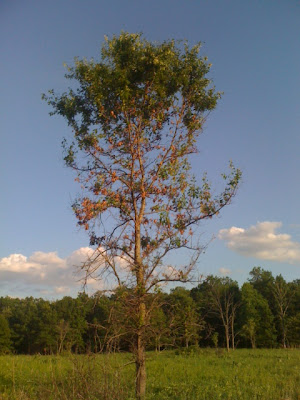A TALE OF TWO OAKS
and how two species
adapt to fire
The bottom 90% of this scarlet oak was singed by fire. Indeed, the lower branches were killed recently on many tall oaks – treasures of the Somme savanna.
This apparent destruction resulted from an intentional
controlled burn.
Burning trees – it’s a bad thing -- yes?
Or is it nature?
When Dara lit the burn, the wind was …
… from the southwest and blew the heat into many trees to
the northeast, oaks among them.
When the time came for new leaves to push last year’s dried
brown out of the way, all those stressed lower branches kept their dead leaves.
Only the very tops of some trees sprouted new leaves.
But it’s more complicated: many large scarlet oaks fried, but most large bur oaks
showed little damage. For thousands of years, bur oak was probably the only
common large tree in this savanna. Of all trees, bur oak is the soldier that
faces down fire at the edges of the groves. Scarlet oak is adapted to burns too,
but in a very different way. Instead of putting its major investment into thick
bark for protection, it often sacrifices its whole top and re-sprouts. Many
woody savanna species are like that, including hazelnut and wild plum. The
fresh post-burn sprouts make these trees and shrubs as dense as ever, but short
enough to mingle with the wildflowers, after a good burn.
The photo below shows a striking contrast between two oaks:
The larger tree is a scarlet. Its whole bottom burned off.
Nestled within that scarlet is a bur. Even its lowest branches withstood the
fire just fine. Burned scarlet branches all around it tell the tale of these two fire species. One survives by retreat and re-sprouting. One survives by armor. Assuming continued burns every year or two, we can expect most of this preserve's scarlet oaks to shrink back to become re-sprout shrubs. Bur oaks will grow and take scarlet's place as the main large tree.



No comments:
Post a Comment